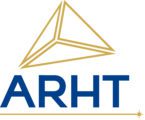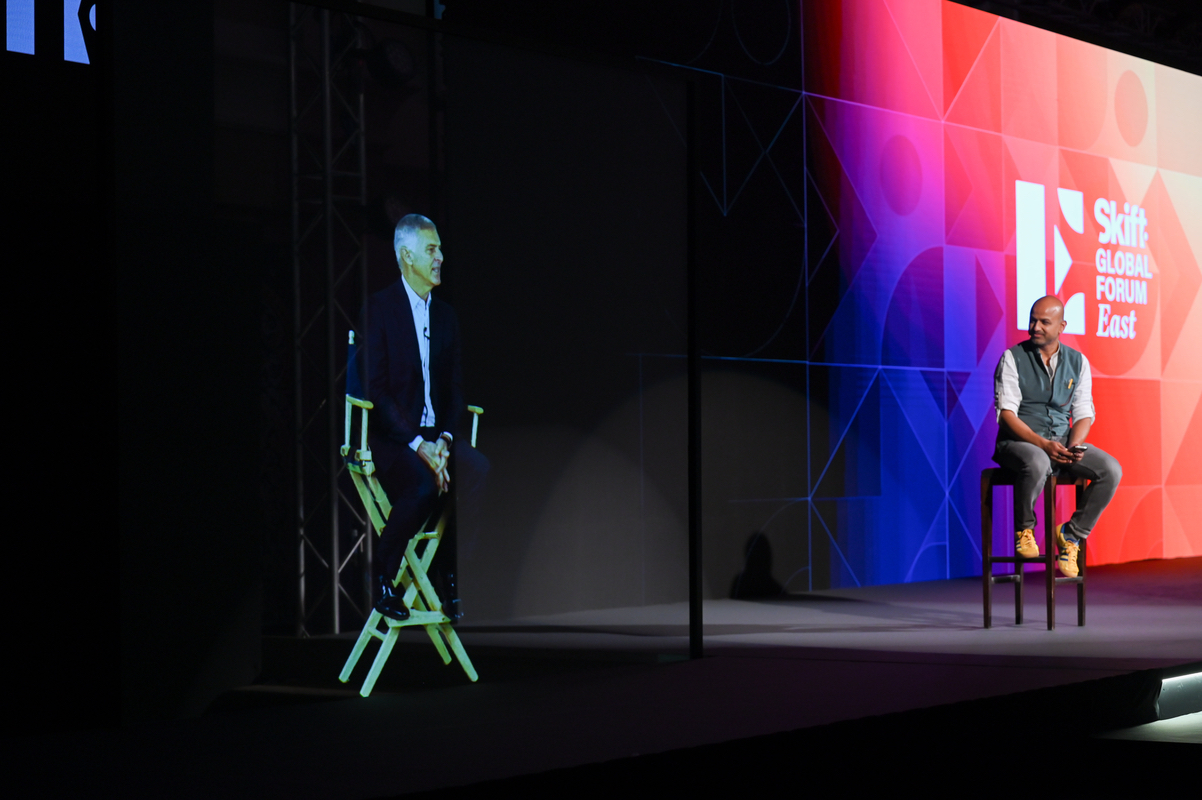Skift Take
The future is here: Plug-and-play hologram technology is now accessible for meetings and events. To find out more about how it works and why it stands to revolutionize the audience experience, Skift Meetings sat down with ARHT Media, a leading supplier of hologram technology.
Have you seen a holographic presentation in person? That’s a question few would ask about a big-screen live stream of a remote speaker, but therein lies the difference between a 2D representation and a 3D illusion. Viewing a hologram speaker is an immersive experience that creates a lifelike effect — with an added “wow” factor that may be even more impressive than the in-person presence of a speaker.
Once the stuff of science fiction, holographic presentations are becoming both more commonplace and more accessible.
If Skift CEO Rafat Ali’s experience is any indication, the technology may soon be coming to an event near you. Less than two months apart, Ali had the experience of speaking both as and to a hologram: First, he presented as a hologram at the ICCA Conference in Krakow in early November 2022; and second, he moderated a fireside chat with Hilton CEO Chris Nassetta beaming into Skift Global Forum East (SGFE) in Dubai as a hologram in mid December.
In both cases, ARHT Media was the company behind the technology. To understand why holograms are quickly gaining popularity, Skift Meetings sat down with Larry O’Reilly, ARHT CEO, and Ellen Van de Woestijne, vice president (VP) of strategic development EMEA for ARHT.
Speaker Holograms: The Future of Events and Meetings
To put it in the simplest terms, holographic presentations are a more immersive alternative to 2D recordings and live streams. Every use case for Zoom also applies to holograms — even internal meetings — but with a full-body, 3D effect that much more closely approximates the in-person experience.
“Your next level up [from Zoom meetings] is a hologram where you have life-like, life-sized visuals and two-way interaction,” says Van de Woestijne.
Unlike Zoom-enabled presentations, however, holograms may be an added bonus as opposed to a second-best last resort.
O’Reilly says that many clients collect audience feedback, and holographic presentations actually score higher on audience impact than those done in person. Referring to Nassetta’s appearance at SGFE, he recalls, “People in the audience got out their phones and started recording it and posting it to social media.”
Benefits of 2D vs. 3D Communication
In contrast to a Zoom call, a hologram provides a full-body, lifelike effect that can help with everything from demonstrating surgical techniques to conveying body-language cues. “More than 50 percent of your communication is body language, and you’re not getting that on a Zoom call,” says O’Reilly. Even knowing when to speak can be an awkward guessing game filled with interruptions when these vital signals are missing.
For this reason, Van de Woestijne believes that holograms bring greater equity in addition to the cost-saving and sustainability-conscious benefits of remote communication. “Zoom is not giving you meeting equity. If you are using holograms with life-like, life-sized representations, you are coming much closer to an in-person meeting.”
O’Reilly adds that the technology comes with a surprise benefit: The hologram creates a Mona-Lisa-like illusion of eye contact no matter where the audience is sitting. “If I’m beaming in for a demo, I’ll say, ‘If you think I’m looking directly at you, put your hand up.’ And all 12 people in the audience always put their hand up and then start laughing.” Even crowds of 5,000 people have reported the same effect, says O’Reilly.
Holograms Evolve to Plug and Play Set Up
Both O’Reilly and Van de Woestijne report that recent improvements in the technology account for its skyrocketing popularity. ARHT’s hologram capsules — what Van de Woestijne calls a “hologram in a box” — mean that set up time has dropped from four or more hours to roughly ten minutes.
While traditional projection methods required careful alignment of each element, ARHT CAPSULE is virtually self-contained. It just needs to be plugged in and connected to ARHT’s servers and software, which compress and encrypt the video feed. While a technician is required to oversee the installation, the process is very simple. At permanent installations, ARHT trains local staff in the technology’s basic functioning, and they’re able to handle it from there. The company also has a network of AV, IT, and rental partners around the world who’ve already been trained in the set-up process.
Two-Way Speaker and Audience Views
For speakers being teleported, the equipment is typically limited to a white screen backdrop, a camera, a monitor just above the lens showing the audience, and then optionally another monitor above that for presentation slides and notes. This arrangement means that when the speaker looks at the audience screen, they appear to be looking right into the lens — and from the audience’s perspective, right at them.
On stage or in the meeting room, another camera is used to capture the audience. The other key piece of equipment is the ARHT hologram capsule itself, as well as cables to connect the device to ARHT’s server and a power source. The ARHT CAPSULE weighs about 500 pounds (230 kilograms), so a mechanized trolley lift is also needed.
Apart from the capsule and the server, all the equipment can be readily rented from local AV providers and is brand agnostic.
Real-Time Interaction
While some still prefer to use pre-recorded hologram videos, the technology now supports real-time communication. The latency (or the lag between input and output of the video feed) is a mere 0.3 seconds or less, rivaling most 2D video streaming options.
O’Reilly points to Rafat Ali’s fireside chat with Chris Nassetta as a prime example of just how naturally conversation can flow between an in-person moderator and a remote holographic speaker. The format can even work well for the fast-paced chatter of a debate, where body language cues can also be especially vital for passing the baton.
Van de Woestijne says that this kind of two-way conversation can be a real game changer: “In events, audiences are still impressed by pre-recorded holograms, but a live interaction will really blow them away.”
How ARHT Clients Are Using Holograms
For one-off events, top use cases include keynote speeches, fireside chats, and experiential marketing activations. Speaker holograms can even be live streamed to multiple locations simultaneously, as ARHT did for a speech by the President of Ukraine Vlodymyr Zelensky last year. “As part of a hub-and-spoke series of tech events, we live streamed his hologram to four different European cities simultaneously on stage,” says Van de Woestijne.
Some clients have gone a step further, making holograms part of their regular communication channels by setting up permanent installations. The top verticals for this service fall into the retail, educational, medical, and entertainment sectors, but government institutions are another key customer. NATO, for example, uses holograms to allow high-ranking military officials to beam into meetings halfway across the globe without having to step on a flight.
ARHT also has partnerships with a number of brick and mortar organizations with permanent hologram capsule installations that are accessible to the public, with WeWork currently offering the service at 29 locations globally — and a contract in place to push this number up to 100 in the near future.
To learn more about the latest hologram technology for meetings and events, visit the ARHT Media website.
This content was created collaboratively by ARHT Media and Skift’s branded content studio, SkiftX.






